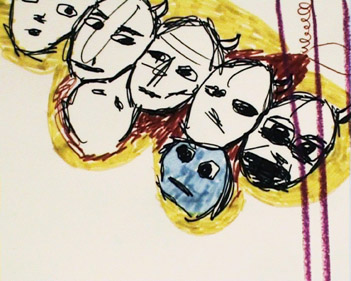Cathrine Dahl
Norwegian contemporary artist Cathrine Dahl’s (b. 1980) practice could be described as several paths that occasionally cross each other. She is intrinsically fascinated by the local history of places and the way stories are passed down to colour our own experience of those places in our own time. One such place is the small town of Norderhov in Norway. A bygone site of pagan worship, it is loaded with mystery and suspense, being the subject of many local ghost stories.
By layering seemingly random images, Dahl mirrors the layering effect of stories passed from mouth to mouth, which inevitably results in distortions, embellishments and the invention of completely new motifs. She constructs scenes and narratives that perpetually branch off haphazardly, as if with a life of their own.
Drawing as conversation
Since autumn 2006 Dahl has been collaborating with fellow Norwegian visual artist Ørjan Aas, using video, drawing and screen printing techniques. Their work takes the form of a continuous conversation realized through drawings and animations on big wooden plates or sheets of paper. The drawings are regularly overworked until the paper disintegrates or the wall is saturated with charcoal, felt-tip pen and oil-pastel.
As in her personal work, Dahl often goes on to pick out a single figure or motif from within the larger picture to examine closer and develop in to something separate. The work becomes a row of developments where one thing leads to another. Sometimes the original idea is lost and becomes only a trace, a sign of passage, whereas other images acquire a new life as a series of drawings, screen prints or a feature in a short film. The focus and interest move from the work’s physical surface to more contextual elements like superstition, humorous fright and the complexity of relations between human and nature, artist and society.
More recently, her interest is increasingly drawn to animation and drawing. A natural progression from her previous practice, unnecessary complexities give way to a cleaner, more confident line of inquiry. The eccentricity of the tales remains the same but the marks that relate them are now executed with more precision and intent.
Norah Nelson

